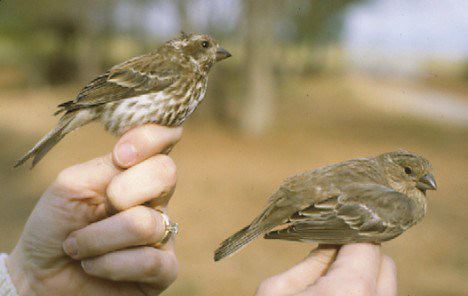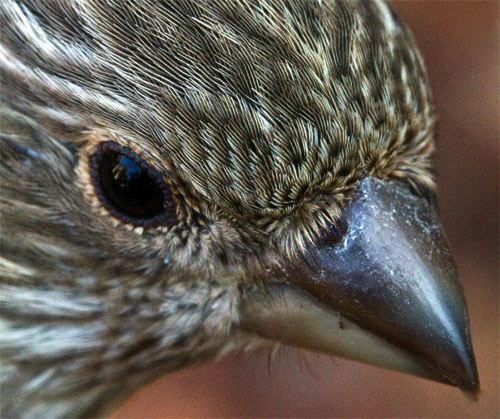|
|
|||
|
THIS WEEK at HILTON POND
22-28 December 2010 Installment #497---Visitor # (Back to Preceding Week; on to Next Week) |
|
SIGN UP FOR 2 OR MORE TRIPS; GET $100 OFF ON EACH Join fellow birders & educators as citizen scientists on 2011 Operation RubyThroat expeditions to observe, capture & band hummingbirds in Belize, Guatemala & Costa Rica. No experience necessary! |
|
HOUSE FINCH FOLLOW-UPS Last week's photo essay dealt with our new hypothesis about migratory behavior of House Finches (HOFI): Based on 29 years of banding work at Hilton Pond Center we suspect there has been a major decrease in the number of HOFI migrating south from breeding grounds up north. The House Finch, a species native to the western U.S. and Mexico, was introduced into the eastern part of the continent in about 1940 when several dozen captive HOFI were released on Long island NY by pet shop owners selling them illegally as "Hollywood Finches." The liberated birds established themselves locally, began breeding, and in winter migrated to warmer climes. In the 1980s and early 1990s we caught hundreds of HOFI most winters here in York SC; by then they had barely extended their breeding range into the Carolinas, so we suspect most captures were migrants. As evidence, eight winter HOFI banded at the Center between 1983 and 1985 were later encountered in locales as far as 690 miles to the north. From the late 1980s on--and despite banding several thousand additional winter HOFI--none of ours from Hilton Pond have been recaptured or found on northern breeding grounds.
All text, charts, maps, tables & photos © Hilton Pond Center Based on the data, it looks as if most or all House Finches we're banding at Hilton Pond these days are year-round residents that breed on or near the property. Our work suggests HOFI (adult male above) are no longer migrating southward in big numbers, but we're not sure what factors might cause such a behavioral shift. Perhaps climate change and/or a proliferation of black sunflower seed feeders have allowed HOFI to remain year-round on their northern breeding grounds, or maybe there's something else going on that may be revealed by another three decades of banding at Hilton Pond Center. In any case, last week's photo essay generated numerous questions from curious Web site visitors, so we're devoting this week's installment to four related topics as "House Finch Follow-ups." All text, charts, maps, tables & photos © Hilton Pond Center 1. FOREIGN RECAPTURES AT HILTON POND We talked at length last week about 14 House Finches banded at Hilton Pond Center that were later encountered outside our home county of York in South Carolina. (Click on the thumbnail below right to open a new browser window with last week's table of "long distance" HOFI encounters. The other HOFI group may be of greater interest because it could shed additional light on whether long distance migration in House Finches is no longer standard behavior. This group (see chart below) includes three HOFI that were banded and released elsewhere by other researchers and then encountered here at Hilton Pond. 3 HOUSE FINCHES BANDED ELSEWHERE AGE KEY
All text, charts, maps, tables & photos © Hilton Pond Center The three House Finches listed in the table above were all banded in summer on their northern breeding grounds and encountered during winter at Hilton Pond Center following a substantial migratory flight. Also, they all made those flights in the early to mid-1980s and no foreign HOFI have been encountered at the Center in winters since.
All text, charts, maps, tables & photos © Hilton Pond Center The map above shows locales for the three HOFI banded elsewhere and recaptured here--plus the 14 Hilton Pond HOFI encountered outside York County SC (as described at length last week). Map numerals correspond to the numbers on our two charts. Since all the "low numerals" are from the 1980s and very early 1990s, maybe House Finches really HAVE given up on long distance migration. 2. BANDING EFFORT There's no question we're banding fewer House Finches than back in the 1980s. We suspect that's due at least in part to a reduction in the number of long-distance migrants that now choose to stay year-round on breeding grounds well to the north of Hilton Pond Center. In full disclosure, however, we should point out that since 2004 part of the decline in HOFI bandings has resulted from our midwinter trips to the Neotropics. Some winters we are gone for up to four or five weeks during the coldest months of the year--studying Ruby-throated Hummingbirds in Central America when it's prime time for trapping and banding House Finches back in the Carolina Piedmont.
All text, charts, maps, tables & photos © Hilton Pond Center Our banding totals this year, in particular, will be adversely affected by weeks in Costa Rica and Belize; by a blistering summer when--for the sake of the birds AND the bander--it was too hot to run mist nets; and by the bone-chilling cold of December 2010 when bitter weather also impeded banding efforts. Interestingly, our most active banding span at Hilton Pond was the first half of the 1990s when we annually averaged twice as many banded birds of most species as during each year in the past decade; nonetheless, only six of our banded House Finches from that period were encountered outside York County, and they were in the neighboring states of Georgia and North Carolina (see map and tables above)--hardly what we'd call long-distance migrants. All text, charts, maps, tables & photos © Hilton Pond Center 3. CONJUNCTIVITIS Several Web site visitors e-mailed us after last week's photo essay to say their House Finch numbers started declining about 10-15 years ago and wondered if conjunctivitis might have led to lower populations and fewer long-distance migrants. We don't know about the latter, but we feel certain mycoplasmosis has caused the demise of a significant percentage of eastern HOFI. Conjunctivitis in House Finches is a secondary symptom that occurs when the bird actually has a respiratory disease caused by a bacterium called Mycoplasma gallisepticum (photomicrograph below left). It is highly contagious, especially among young birds under stress. Historically, native western populations of House Finches did not have mycoplasmosis-induced conjunctivitis even though the bacterium occurs almost universally among birds, and we've pondered how it is the eastern population could be decimated by the disease--which less commonly affects goldfinches and other native species. All text, charts, maps, tables & photos © Hilton Pond Center 4. HOUSE FINCHES vs. PURPLE FINCHES We frequently hear from people in the Carolina Piedmont who mention they have Purple Finches (PUFI) nesting on their porches or coming to seed feeders in July. These folks are typically surprised when we tell them PUFI do not nest in the Piedmont or occur here in midsummer, so what they're observing have to be House Finches. Occasionally a homeowner will indignantly reply the birds absolutely must be Purple Finches because House Finches don't occur in the eastern U.S., at which point we inquire about the copyright date of their bird book. Both Purple Finches, Carpodacus purpureus, and House Finches, C. mexicanus, do show up at WINTER feeders across the Carolinas, so folks often ask how to tell these two Carpodacus species apart. Banders have it easy because PUFI almost always nip the hand that bands them, while HOFI seldom do. The "bite test" won't work for feeder watchers, so we point out the shape of the upper bill--decurved in HOFI and straight in PUFI--as our favorite diagnostic difference. We also offer several other hints (see below) for differentiating the two species in field or at feeder. First, however, here's one big giant not-to-be-forgotten caveat: By this time of year, just because all red HOFI are males and all brown HOFI are females one should NOT assume brown PUFI are females. House Finch males turn red during their first fall, but Purple Finch males take TWO autumns to become raspberry-colored. Thus, a brown PUFI at your winter feeder in the Carolina Piedmont and elsewhere is either an immature male or a female of undetermined age.
All text, charts, maps, tables & photos © Hilton Pond Center With experience, a "red" adult male Purple Finch (above left) can be easily separated from a "red" adult male House Finch at the feeder. Some hints:
All text, charts, maps, tables & photos © Hilton Pond Center Many observers find female Carpodacus finches (female PUFI, above left) easier to differentiate than their male counterparts. Below are some hints for doing so:
All text, charts, maps, tables & photos © Hilton Pond Center
All text, charts, maps, tables & photos © Hilton Pond Center We might also mention that--depending on diet--both House Finches and Purple Finches may bear feathers that are some shade of gold rather than the standard raspberry or red. Older females of both species may acquire a pink wash, and HOFI females in particular often have pink or gold rumps (above).
All text, charts, maps, tables & photos © Hilton Pond Center Unlike House Sparrows--which were imported from Europe and quickly displaced native North American cavity nesters such as bluebirds and woodpeckers--House Finches brought from the western U.S. seem to have found an "empty niche" in the Carolina Piedmont. HOFI tolerate people, come to feeders, often nest in places such as hanging baskets, and don't appear to compete with species that occur here naturally. We suspect the "newly established" eastern population, which got its start just seven decades ago, might still be adjusting to its new range. It's entirely possible eastern HOFI have given up on long-distance migration, and the species is likely to survive the threat of mycoplasmosis, but no one knows for sure--all the more reason to offer this and future "House Finch Follow-ups." All text, charts, maps, tables & photos © Hilton Pond Center If you have a Twitter account and liked this page, you can recommend "This Week at Hilton Pond" to your followers by clicking on the Tweet button: Tweet Follow us on Twitter: @hiltonpond
|



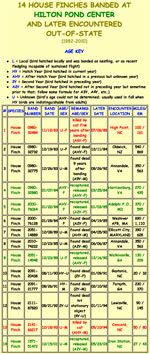
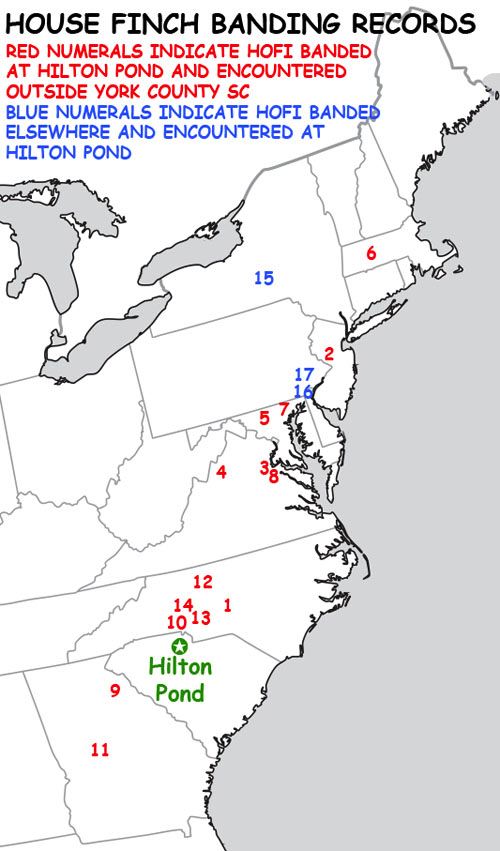

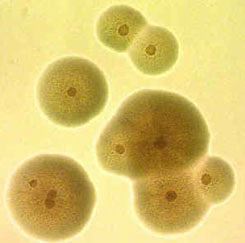 The first major outbreak among eastern House Finches occurred in mid-Atlantic states in 1994. Here at Hilton Pond Center we have captured infected HOFI at all times of the year although the disease seems more common in warm weather months. Some House Finches exhibit conjunctivitis--an inflammation of the conjunctiva, a transparent mucous membrane that covers the eyeball and lines the eyelid--as a mild irritation in just one eye, while other individuals have both eyes weeping and nearly swollen shut by the disease (below right). There's little doubt severe cases of conjunctivitis impair vision sufficiently to interfere with feeding and flying, but of greater concern is that the respiratory problem itself can so weaken the bird it soon dies. We know from local recaptures of HOFI with conjunctivitis that some individuals do survive mycoplasmosis; we suspect that isn't always the case.
The first major outbreak among eastern House Finches occurred in mid-Atlantic states in 1994. Here at Hilton Pond Center we have captured infected HOFI at all times of the year although the disease seems more common in warm weather months. Some House Finches exhibit conjunctivitis--an inflammation of the conjunctiva, a transparent mucous membrane that covers the eyeball and lines the eyelid--as a mild irritation in just one eye, while other individuals have both eyes weeping and nearly swollen shut by the disease (below right). There's little doubt severe cases of conjunctivitis impair vision sufficiently to interfere with feeding and flying, but of greater concern is that the respiratory problem itself can so weaken the bird it soon dies. We know from local recaptures of HOFI with conjunctivitis that some individuals do survive mycoplasmosis; we suspect that isn't always the case.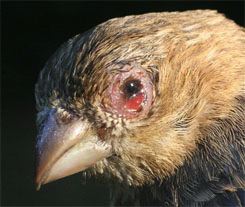 (Mycoplasmosis also causes serious losses in commercial chicken and turkey operations.) We've always thought the phenomenon has to do with limited genetic diversity in an introduced population of House Finches that arose from just a few dozen birds released 70 years ago in New York State. Perhaps a high susceptibility for mycoplasmosis exists because our eastern HOFI are so closely related to each other. Possibly defeating this argument is the fact that western HOFI populations recently have been infected by mycoplasmosis and are exhibiting the same eye problems, although at a seemingly lower rate. Again, we don't know if conjunctivitis has significantly diminished long-distance House Finch migration, but any bird with respiratory problems and eyes swollen shut obviously would not be able to undertake a lengthy migratory flight.
(Mycoplasmosis also causes serious losses in commercial chicken and turkey operations.) We've always thought the phenomenon has to do with limited genetic diversity in an introduced population of House Finches that arose from just a few dozen birds released 70 years ago in New York State. Perhaps a high susceptibility for mycoplasmosis exists because our eastern HOFI are so closely related to each other. Possibly defeating this argument is the fact that western HOFI populations recently have been infected by mycoplasmosis and are exhibiting the same eye problems, although at a seemingly lower rate. Again, we don't know if conjunctivitis has significantly diminished long-distance House Finch migration, but any bird with respiratory problems and eyes swollen shut obviously would not be able to undertake a lengthy migratory flight.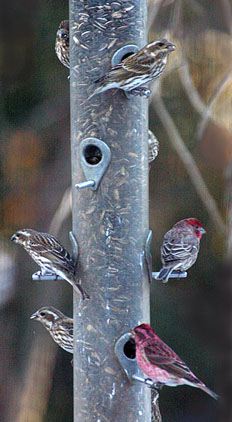 Invariably they have an older field guide published prior to about 1975 when House Finches began breeding in the Southeast after their early 1940s release in New York.
Invariably they have an older field guide published prior to about 1975 when House Finches began breeding in the Southeast after their early 1940s release in New York.
